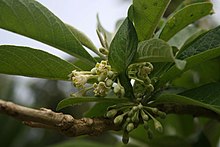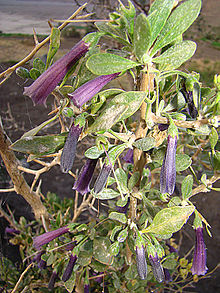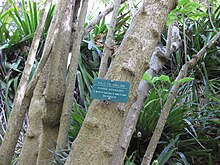| Iochroma arborescens | |
|---|---|

| |
| Scientific classification | |
| Kingdom: | Plantae |
| Clade: | Tracheophytes |
| Clade: | Angiosperms |
| Clade: | Eudicots |
| Clade: | Asterids |
| Order: | Solanales |
| Family: | Solanaceae |
| Genus: | Iochroma |
| Species: | I. arborescens
|
| Binomial name | |
| Iochroma arborescens (L.) J.M.H.Shaw
| |
Iochroma arborescens is a species of flowering plant in the genus Iochroma, belonging to the nightshade family Solanaceae. Formerly it was considered the single species in the monotypic genus Acnistus. Common names include gallinero (= 'henhouse'), mata-gallina (= 'chicken-killer'), fruta-de-sabiá (= 'thrush-fruit'), hollowheart, wild tobacco, siyou, bastard sirio, galán arbóreo, tabaco de monte (= 'mountain tobacco'), nigüito, marieneira, güitite, and tabak djab (= 'devil's tobacco').[1]
Etymology[edit]
The former genus name Acnistus has been claimed[2] to be a compound of the Greek prefix 'a-' and Latin 'cnistus' [ misreading of Latin 'crista' - a crest ? ] which would give the meaning 'without a crest'. A more likely derivation, however, is from the single Homeric Greek word άκνηστις (pron. 'akneestis' / 'aknistis'), meaning 'backbone',[3] possibly in reference to the backbone-like, white, longitudinal stripes running up the centre of each green patch on the exterior of the corolla.
Publication[edit]
The genus name Acnistus was published by Austrian botanist Heinrich Wilhelm Schott in Wiener Zeitschrift für Kunst, Litteratur, Theater und Mode, (- abbreviation :'Wiener Z. Kunst' - a journal featuring botanical descriptions and illustrations published between the years 1817 and 1848 ) : Vol. 4: 1180 on the 28th of November of the year 1829. The binomial Acnistus arborescens (L.) Schltdl. was published by German botanist Diederich Franz Leonhard von Schlechtendal in the journal Linnaea, Vol. 7 (pps. 67–68) in the year 1832.[4]
History of classification[edit]

The case of Acnistus arborescens is remarkable, considering the vicissitudes of its long and varied taxonomic history; it has received 29 botanical names with 17 different epithets associated to 6 generic names.- Armando Hunziker[5]
Since Hunziker made the observation quoted above, the case of Acnistus arborescens has grown yet more remarkable : the Plant List enumerates no fewer than 11 genera to which the plant has been assigned since it first became known to science : Acnistus, Atropa, Brachistus, Capsicum, Cestrum, Dunalia, Ephaiola, Eplateia, Fregirardia, Lycium and Pederlea. The brief assignment to the genus Cestrum is particularly wide of the mark, given the fact that the generic name Cestrum actually furnished the name of the subfamily Cestroideae (Acnistus belongs to the subfamily Solanoideae, not Cestroideae. Atropa is an exclusively Old World genus. The obsolete genus Fregirardia formerly contained various Capsicum species and a single species of Cestrum; while the obsolete genera Ephaiola, Eplateia and Pederlea are referable solely to Acnistus arborescens. Of the genera in the list above, Dunalia is the genus most closely related to Acnistus, belonging as it does to the same tribe within the Solanoideae – namely Physaleae (named for Physalis).[6] Indeed, Hunziker draws attention to the fact that, such is the closeness of the relationship between Acnistus, Dunalia and Iochroma...
...these three genera were merged by Sleumer,[7] but soon after Hunziker[8] called attention to the elaborate stapet[9] of Dunalia and its taxonomic importance as well. – Armando Hunziker[5]
[ Note : the uncommon botanical term stapet (employed above by Hunziker in reference to the genus Dunalia) is used to designate congenital fusion of stamens to petals,[10] which is found commonly in association with sympetaly in core eudicots. However, this phenomenon is rarely found in rosids[11] The word stapet is a portmanteau of sorts, combining as it does abbreviated forms of the words stamen and petal ].
List of 50 synonyms by genus[edit]
- Acnistus aggregatus (Ruiz & Pav.) Miers
- Acnistus benthamii Miers
- Acnistus campanulatus (Lam.) Merr.
- Acnistus cauliflorus Schott
- Acnistus cerasus Hieron. ex Seckt
- Acnistus confertiflorus Miers [ This name is unresolved, but some data suggest that it is synonymous with Iochroma confertiflorum (Miers) Hunz. – but see also section below on closeness / hybridisation of genera Acnistus and Iochroma ].
- Acnistus floccosus Werderm.
- Acnistus floribundus (Kunth) G.Don
- Acnistus geminifolius Dammer
- Acnistus grandiflorus Miers
- Acnistus guayaquilensis (Kunth) G.Don
- Acnistus lehmannii Dammer
- Acnistus macrophyllus (Benth.) Standl.
- Acnistus miersii Dunal
- Acnistus plumieri Miers
- Acnistus pringlei Fernald
- Acnistus punctatus Ridl.
- Acnistus ramiflorus Miers
- Acnistus sideroxyloides (Willd. ex Roem. & Schult.) G.Don
- Acnistus virgatus Griseb.
- Atropa arborea Willd. ex Dunal
- Atropa arborescens L.
- Atropa arborescens Roem. & Schult.
- Atropa sideroxyloides Willd. ex Roem. & Schult.
- Atropa solanacea All. ex Steud.
- Brachistus oblongifolius Miers
- Brachistus physocalycius D.A.Sm.
- Brachistus riparius (Kunth) Miers
- Capsicum oblongifolium (Miers) Kuntze
- Cestrum campanulatum Lam.
- Cestrum cauliflorum Jacq.
- Cestrum cauliflorum Sieber ex Bercht. & C.Presl
- Cestrum kohauti Bercht. & J.Presl
- Cestrum macrostemon Sessé & Moç.
- Dunalia arborescens (L.) Sleumer
- Dunalia arborescens var. campanulata (Lam.) J.F.Macbr.
- Dunalia campanulata (Lam.) J.F.Macbr.
- Dunalia macrophylla (Benth.) Sleumer
- Ephaiola odorata Raf.
- Eplateia arborescens (L.) Raf.
- Fregirardia riparia (Kunth) Dunal
- Lycium aggregatum Ruiz & Pav.
- Lycium arborescens (L.) Spreng.
- Lycium grandifolium Willd. ex Roem. & Schult.
- Lycium guayaquilense Kunth
- Lycium macrophyllum Benth.
- Lycium ovale Roem. & Schult.
- Pederlea aggregata (Ruiz & Pav.) Raf.
- Pederlea arborescens (L.) Raf.
- Pederlea cestroides Raf.
Taxonomy[edit]
It is a member of the subtribe Iochrominae, which contains the following genera:


Iochroma Benth. was the genus most closely related to the monotypic genus Acnistus, differing by its induplicate corolla aestivation – with five conspicuous plaits lacking in Acnistus, its (Iochroma) accrescent calyx (unchanged or only slightly accrescent in Acnistus) and its (Iochroma) larger anthers (1.4 – 2.1 mm long in Acnistus, but 2.8 – 4.7 mm long in Iochroma).[5]
Concerning the very close relationship of Iochroma with the monotypic genus Acnistus, it is of the utmost importance to make intensive collections properly annotated in southern Ecuador and northern Peru; in this region native populations grow, with yellow-coloured corollas which appear to be intermediate between both genera. – Armando Hunziker (2001)[5]
In Hunziker’s revision of Acnistus,[13] he acknowledged that Acnistus has greatest affinity to the genus Iochroma. The important differences he noted between them were the small flowers and anthers of Acnistus, the calyx (accresent in Iochroma but not in Acnistus), and the bud aestivation (induplicate in Iochroma but valvate in Acnistus). Confusing this demarcation are a few species currently placed in Iochroma that have the latter two characteristics of Acnistus. For example, Iochroma ellipticum and I. confertiflorum, two large-flowered species that were transferred from Acnistus by Hunziker,[14][13] have valvate bud aestivation and lack a strongly accresent calyx. This combination of traits is also found in two recently named species, I. edule and I. salpoanum[15][16] and in I. peruvianum. Furthermore, field observations of these five Iochroma spp. (S. D. Smith, personal observation) indicate that they share with Acnistus a conspicuous green mark on the inner surface of the corolla lobe, which fades to yellow as the flower ages. Thus, it is not surprising that Acnistus and these five other species form a well-supported clade in our analyses...but whether this group should be officially segregated from Iochroma deserves careful consideration...The small-flowered form traditionally named Acnistus arborescens occurs from Argentina to Mexico and the Caribbean and is morphologically variable...A. arborescens [may] refer to a lowland progenitor form that has given rise to multiple novel higher-elevation forms... A. arborescens may occasionally hybridize in nature with related higher-elevation taxa such as Iochroma confertiflorum (S. D. Smith, personal observation)... – Stacey DeWitt Smith and David A.Baum (2006)[17]
Description[edit]
Iochroma arborescens forms a large shrub or small tree up to 10 meters in height. It flowers in clusters on naked branch parts below the leaves. Leaves are alternate, simple, elliptical, narrow to a long v-shape at the base, variably narrowed to a point at the tip, 15 to 30 cm long and 5 to 15 cm wide, margins entire or slightly wavy, hairless except when young. Young stems and young leaves have rusty hairs. The fragrant flowers bloom in clusters of 30 or more, with broadly funnel-shaped tubes about 1.2 cm long and recurving lobes. The protruding stamens are greenish-white to cream. The bright orange fruit is round, and about 1 cm across. There is evidence that these fruits are bird-dispersed.[18]
The plant flowers sporadically throughout the year and fruits generally from March to July.[19]
Distribution and habitat[edit]
The plant is native to Central and South America, and the Caribbean, a species characteristic of Montane cloud forests (in clearings, forest edges etc.) between 300 and 2000m elevation. In Puerto Rico and the United States Virgin Islands, it is classified by the US Department of Agriculture as a native plant species.[20]
Edibility/inedibility of fruit[edit]

Some sources claim that the attractive fruits are edible (though causing diarrhea if consumed to excess) : others that they are inedible, due to bitterness or insipidity. The variability in chemistry of different populations (see below) may account for these conflicting accounts.[21] In addition to being consumed raw, the fruits have also been used to prepare fruit preserves and / or jellies .[22]
Medicinal uses[edit]

Leaf extracts in have been used in folk medicine for cancerous growths, and scientific studies indicate that compounds present in the plant display in vitro cytotoxic activity against a panel of human cancer cell lines.[23] A hot infusion of the leaves or bark has been used for bruises and sprains.[24]
Psychoactivity[edit]
In Brazil, the plant is considered to be psychoactive, possessing narcotic and depressant properties.[25] The patois name Tabak djab (Devil's tobacco) may be significant in this context, suggesting that the leaves of the plant may have been smoked. Compare the Spanish name Tabaco del Diablo – also meaning Devil's Tobacco – applied to Lobelia tupa, a narcotic plant smoked by the Mapuche of Chile.[26]
Toxicity[edit]
Iochroma arborescens is seldom portrayed in the literature as a particularly poisonous plant, but two sets of herbarium notes from dried specimens held by the New York Botanical Garden present a different picture : a specimen collected in Peru bears the note 'sap very poisonous' and gives the common name 'Catahui', while another collected in Martinique under the synonym Atropa arborescens carries the German note 'Die Pflanze enthält narkotisch giftige Stoffe' (the plant contains narcotic poisons).[27]
Chemistry[edit]
The plant contains withanolides, including cytotoxic withaphysalins.[28] An alkaloid, acnistine is also sometimes present,[29] studies having indicated that this widespread tropical American species contains a number of chemical races, other analyses of the same species having yielded yet other compounds.[30] Ayensu (1981) lists alkaloids, glycosides, organic acids, saponins and tannins as constituents of plant material collected in Trinidad and Dominica.
The essential oil from leaves harvested from a population of I. arborescens growing in the vicinity of Mérida, Venezuela, has been isolated by hydrodistillation. The chemical composition of the leaf oil thus recovered was determined by GC-FID and GC-MS and the most abundant components found to be (Z)-hex-2-enal (40.7%) and estragol (25.6%).[31]
Influence of floral scent upon insect pollination[edit]

The flowers of I. arborescens secrete a fragrant compound of rare occurrence (though found also in roses and the flowers of the Amaryllid Narcissus tazetta) called orcinol dimethyl ether or 3,5-Dimethoxytoluene. This volatile is almost undetectable by the human nose, but (as revealed by experiments) readily detectable by the olfactory sense of honey bees.[32]
Cultivation[edit]
Iochroma arborescens is grown as an ornamental tree for gardens and natural landscaping projects for its attractive flowers and abundant beautiful golden fruit, the latter being relished by many species of birds – whence its Brazilian common name Fruta-de-sabiá (Portuguese for 'thrush fruit').[33]
Gallery[edit]
-
Plate from Flore médicale des Antilles (1827) by J. Descourtilz, bearing the French title 'Nicotiana-leaved (i.e. Tobacco-leaved) belladonna' and showing anatomy of flower and fruit of Acnistus arborescens.
-
Acnistus arborescens, cultivated plant, Lankester Botanical Garden Costa Rica.
References[edit]
- ^ Francis, J. K. Acnistus arborescens. USDA Forest Service, International Institute of Tropical Forestry, Jardín Botánico Sur, Puerto Rico.
- ^ https://davesgarden.com/guides/botanary/search.php?search_text=Acnistus Retrieved 12.12 on 31/1/19
- ^ Cunliffe, Richard John A Lexicon of the Homeric Dialect, pub. Blackie and Son Ltd. 1924, page 16.
- ^ Solanaceae Source http://solanaceaesource.org/search/site/Wiener Retrieved 16.23 on 21/2/19
- ^ a b c d Armando T. Hunziker: The Genera of Solanaceae. A.R.G. Gantner Verlag K.G., Ruggell, Liechtenstein 2001. ISBN 3-904144-77-4 pps. 199–202.
- ^ a b Page Acnistus arborescens The Plant List http://www.theplantlist.org/tpl1.1/record/kew-2618239 retrieved 9.42 a.m. 14/2/19
- ^ Sleumer, H. 1950. Estudios sobre el género Dunalia H. B. K. Lilloa 23 : pps. 117–142.
- ^ Hunziker, A.T. 1960. Estudios sobre Solanaceae II. Sinopsis taxonómica del género Dunalia H. B. K. Boletín de la Academia Nacional de Ciencias en Córdoba, 41 (2) : pps. 211–244.
- ^ Endress, P. K. 2010a. Flower structure and trends of evolution in eudicots and their major subclades. Annals of the Missouri Botanical Garden 97: 541–583.
- ^ Ritterbusch A. Morphologisches Beschreibungsmodell tubiflorer Kronen, ein Beitrag zur Terminologie und Morphologie der Asteriden-Blüte, Botanische Jahrbücher für Systematik , 1991, vol. 112 (pg. 329–345)
- ^ Endress PK, Matthews ML. Progress and problems in the assessment of flower morphology in higher-level systematics, Plant Systematics and Evolution , 2012, vol. 298 (pg. 257–276)
- ^ Kew Plants of the World Online http://powo.science.kew.org/taxon/urn:lsid:ipni.org:names:1016238-1 Retrieved 15.23 on 21/219.
- ^ a b Hunziker, A. T. 1982. Estudios sobre Solanaceae XVII. Revisión sinóptica de Acnistus. Kurtziana 15: 81–102.
- ^ Hunziker, A. T. 1977. Estudios sobre Solanaceae VIII. Part IV. Sobre dos nuevas secciones de Iochroma y dos novedades a nivel específico. Kurtziana 10: 21–25.
- ^ Leiva G., S. 1995. Una nueva especie de Iochroma (Solanaceae: Solaneae) del norte del Peru ́. Arnaldoa 3: 41–44.
- ^ Leiva G., S., P. A. Lezama, and V. S. Quipuscoa. 2003. Iochroma salpoanum y I. squamosum (Solanaceae: Solaneae), dos nuevas especies andinas del norte del Peru ́. Arnaldoa 10: 95–104.
- ^ De Witt, S. and Baum, David A. 2006. Phylogenetics of the Florally Diverse Andean Clade Iochrominae (Solanaceae) American Journal of Botany 93(8): 1140–1153.
- ^ Cruz, Alexander (1981). "Bird Activity and Seed Dispersal of a Montane Forest Tree (Dunalia arborescens) in Jamaica". Biotropica. 13 (2): 34–44. doi:10.2307/2388068. JSTOR 2388068.
- ^ Susan Iremonger (2002). A Guide to Plants in the Blue Mountains of Jamaica. University of the West Indies Press. p. 42. ISBN 978-976-640-031-6.
- ^ USDA
- ^ http://citeseerx.ist.psu.edu/viewdoc/download?doi=10.1.1.214.701&rep=rep1&type=pdf Retrieved 21.09 on 30/1/19.
- ^ Usher, George A Dictionary of Plants Used by Man, pub. Constable 1974 p. 17
- ^ Quattrocchi, Umberto (2012). CRC World dictionary of medicinal and poisonous plants: common names, scientific names, eponyms, synonyms and etymology, pub. CRC Press Taylor and Francis Group. Vol I : A-B, pps. 57-8.
- ^ New ceramides from Acnistus arborescens J. Braz. Chem. Soc. Vol. 21 no. 5 pps. 867–871, 2010 Maia, Veras, Braz-Filho et al.
- ^ Rafaela Denise Otsuk1, João Henrique Ghilardi Lago, Lucia Rossi, José Carlos Fernandes Galduróz and Eliana Rodrigues (2010). "Psychoactive Plants Described in a Brazilian Literary Work and their Chemical Compounds". Central Nervous System Agents in Medicinal Chemistry. 10 (3): 218–237. doi:10.2174/1871524911006030218. PMID 20557283.
{{cite journal}}: CS1 maint: multiple names: authors list (link) CS1 maint: numeric names: authors list (link) - ^ Emboden, William, Narcotic Plants – Hallucinogens, stimulants, inebriants, and hypnotics, their origins and uses 2nd edition, revised and enlarged, pub. Macmillan Publishing Co., Inc., New York 1979, ISBN 0-02-535480-9, pps. 120–121.
- ^ Siri von Reis and Frank J. Lipp, Jr. New Plant Sources for Drugs and Foods from the New York Botanical Garden pub. Harvard University Press 1982.
- ^ Planta Med. 2004 Jun;70(6):551-5. Cytotoxic epimeric withaphysalins from leaves of Acnistus arborescens Veras ML1, Bezerra MZ, Braz-Filho R, Pessoa OD, Montenegro RC, do O Pessoa C, de Moraes MO, Costa-Lutufo LV.
- ^ Raffauf, R.F. A Handbook of Alkaloids and Alkaloid-Containing Plants 1970
- ^ Barata L. et al.Chem. Abstr. 75 (1971) 115901
- ^ Composition of Essential Oil from the Leaves of Acnistus arborescens (L) Schlecht from the Venezuelan Andes Article in Journal of essential oil-bearing plants JEOP 11(2):168–170 · March 2013
- ^ Natalia Dudareva; Eran Pichersky (27 March 2006). Biology of Floral Scent. CRC Press. p. 95. ISBN 978-0-8493-2283-9.
- ^ Frisch, Johan Dalgas & Frisch, Christian Dalgas, Aves Brasileiras e Plantas que as atraem, São Paulo, 2004, Dalgas Ecotec, 3rd. edition, ISBN 85-85015-07-1, page350

